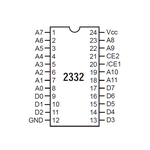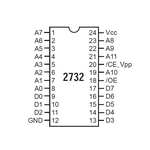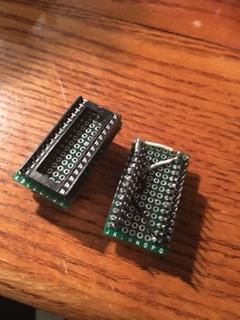Page 3 of 4
Re: My first try at EPROMs
Posted: Sun Nov 19, 2017 5:00 am
by MCes
This different eproms have some differences in pinout,
and if PCB was done for a 64k 24pin (as commodore made.. 2364 pinout) you have to adapt your eprom rewiring some pins or using an adaptor or.... you have to use another eprom "pin-compatible" as old Motorola (ask to Eslaption) or the 27HC641:
http://sleepingelephant.com/ipw-web/bul ... f=3&t=8320
http://sleepingelephant.com/ipw-web/bul ... =11&t=8434
Re: My first try at EPROMs
Posted: Sun Nov 19, 2017 12:15 pm
by Floopy
MCes wrote: have to use another eprom "pin-compatible" as old Motorola (ask to Eslaption) or the 27HC641:
My programmer (TL866) does not support them and the prices are incredibly high. Thanks for the advice though

I was looking at the pinout on 2332 and 2732 and form what it looks like A11 is the only different pin and the two others.

- 2332th.png (11.21 KiB) Viewed 1439 times

- 2732th.png (11.6 KiB) Viewed 1439 times
Re: My first try at EPROMs
Posted: Sun Nov 19, 2017 12:19 pm
by Floopy
Another thing for you silicon lovers. I have these four chips that where left after the sorting, but I can't find anything on them. This time I have no clue

The first three seemed to be manufacture by AMD seeing the logo.
Re: My first try at EPROMs
Posted: Sun Nov 19, 2017 1:38 pm
by MCes
9LS10 is equivalent at 74LS10,
(AMD)9016D are Dinamic RAM 16Kx1bit (D= 250nS):
http://www.minuszerodegrees.net/memory/4116.htm
Re: My first try at EPROMs
Posted: Sun Nov 19, 2017 2:13 pm
by Floopy
MCes wrote:9LS10 is equivalent at 74LS10,
(AMD)9016D are Dinamic RAM 16Kx1bit (D= 250nS):
Thanks very much they will come in handy later.
Re: My first try at EPROMs
Posted: Sun Nov 19, 2017 7:37 pm
by eslapion
Floopy wrote:MCes wrote: have to use another eprom "pin-compatible" as old Motorola (ask to Eslaption) or the 27HC641:
My programmer (TL866) does not support them and the prices are incredibly high. Thanks for the advice though

The TL866 is inexpensive for a reason; it supports only the very standard 27XX and 27CXX series of EPROMs. It doesn't program any of the 27C400/800/160/322 EPROMs which are pin compatible with Amiga ROMs and it doesn't support the MCM68764/66/27HC641 which are pin compatible with Commodore 8 bit systems ROMs.
Not incredibly useful, IMHO.
Re: My first try at EPROMs
Posted: Sun Nov 19, 2017 8:21 pm
by Floopy
eslapion wrote:
The TL866 is inexpensive for a reason; it supports only the very standard 27XX and 27CXX series of EPROMs. It doesn't program any of the 27C400/800/160/322 EPROMs which are pin compatible with Amiga ROMs and it doesn't support the MCM68764/66/27HC641 which are pin compatible with Commodore 8 bit systems ROMs.
Not incredibly useful, IMHO.
In my case I don't have 120$ to spend on an IC programmer, but I do agree that it should support more IC's.
Re: My first try at EPROMs
Posted: Sun Nov 19, 2017 8:35 pm
by Floopy
I just checked but if your chip is pin compatible with another one, even though they are different markings, and it has the same programming algorithm. Then you can program it, although this doesn't work with all chips.
Re: My first try at EPROMs
Posted: Mon Nov 20, 2017 12:59 am
by norm8332
You can in some cases make adapters to allow use of unsupported chips. For instance I made an adapter to burn old TI 2532s with 2732 software settings using my Willem 3.5 board, and the same method with the MCM68764 etc.. The only real limitation of the TL866 (I have one too) is the limit of 21V max. Some old chips need 25V. With the older chips that require a long program pulse time you can just write them multiple times to "add up" the time and charge to the proper levels. I always check the spec sheets because the different manufacturer chips may have different programming requirements. for example Those old TI 2532s required a super long 50 ms programming pulse and 25V. Programming them 4 times at the Willem's max of 12 ms did the trick.
Re: My first try at EPROMs
Posted: Mon Nov 20, 2017 11:23 am
by Floopy
I think it just comes down to usage. I won't ever need it to program anything complex and it's just what I need. Unless I find a cheap professional one someday

Re: My first try at EPROMs
Posted: Sat Dec 02, 2017 12:44 pm
by Floopy
I got some time to make better looking adapters. If I can I will try to make a pcb version that way I can spend more time using them instead of making them, seeing that it took me 1/2 an hour to make these two.

- 24331542_870950833064905_1470831310_n.jpg (16.44 KiB) Viewed 1365 times
Re: My first try at EPROMs
Posted: Sat Dec 02, 2017 5:03 pm
by norm8332
Looks good. I can't tell by the picture, but just in case..I recommend the thinner pin headers like these round ones
https://www.ebay.com/itm/172001313010 <-the 2.45mm is a typo it's 2.54.
The standard square pins tend to loosen up the IC sockets because they are pretty thick. If you ever use an IC in the socket again, it may have poor contact. Especially with the single-wipe commodore sockets.
Re: My first try at EPROMs
Posted: Sat Dec 02, 2017 5:19 pm
by Floopy
I just barely noticed, I was inserting them and the sockets became loose

. I haven't inserted them since, but now at least I don't have to use a lot of force to insert the pins

Again my bad not being informed.
Re: My first try at EPROMs
Posted: Sat Dec 02, 2017 9:22 pm
by norm8332
The one thing I dislike about the round ones is that you have to be careful not bend the pins when inserting and removing them because they will snap off if bent just a little bit and they bend pretty easy. They aren't nearly as durable as the square ones. I just try and keep the board level when inserting/removing. I haven't had them bend/break when being careful. I used them on some Swinsids I made for the C64 and they have held up to several swaps. They do keep the sockets nice and tight.
Re: My first try at EPROMs
Posted: Wed Dec 13, 2017 7:26 pm
by Floopy
So I know I keep asking and reviving this post, but I don't want to make another one.
I got another batch of used IC's and I've struggled to find the datasheet for 70% of the IC's. For some reason the members on this forum are better at identifying IC's than me. Probably because I don't know what I'm doing.
Here are a few pictures...
The first picture show two different types of IC's; one is a RAM IC and the other I have no idea. The only info I found with the HD26501 is a sheet saying it's obsolete.
Now the second picture is more of a question: Why do some National Semiconductor IC's have two numbers like that?
My last question is: What can I do with a MOS 6530? The lot had a few and I'm not sure what to do with them.
Thanks!